
Specimen management is an essential part of the microbiology laboratory’s testing process. It includes the preparation of specimens, collection, transport, and storage. It also entails communicating laboratory needs to the patient’s healthcare team. This article offers guidance on how to handle these steps correctly. It is a comprehensive guide that addresses the needs of all healthcare team members involved in patient care.
Preparation
Specimens received for microscopical analysis must be prepared appropriately. Improper preparation may obscure microstructural features or create artifacts that can be misinterpreted.
Paraffin section preparations must also be adequately prepared before being mounted on a microscope slide and examined. This is particularly important in the microscopy of cellular tissue or vascular structures using the backscattered electron (BSEM) technique.
A wide range of methods can support fresh tissue when cut and sliced into sections (slivers) that can be observed under the microscope.
Usually, this is done with a “wet mount,” where the specimen is placed in a drop of liquid on the slide. This may be a water-based solution or a colored stain added to the model before it is deposited on the decline. The specimen is then covered with a coverslip, ready for examination under the microscope.
Collection
Collecting specimens is an essential part of laboratory testing. Depending on the test, specimens can include serum samples, virology swab samples, biopsy and autopsy tissue, cerebrospinal fluid, whole blood for PCR, and urine samples.
Specimens should be labeled correctly to ensure proper tracking of results and patient care. The most effective way to do this is by using bar-code scanning devices to track samples from their receipt in the laboratory to their final storage, testing, and results distribution.
During a routine audit, it was noted that six incidents of specimens not being labeled occurred from December 2016 to October 2018. One incident was rectified, and no patients were harmed. However, this data led to identifying a critical area for improvement to prevent future incidents.
Transport
The transport of specimens for laboratory testing can occur in various ways. Whether a healthcare professional collects the specimen or a specialized courier transports it, samples must be promptly shipped to the laboratory.
Specimens must be packaged and labeled appropriately to ensure they are safe and will be tested as requested. This involves identifying each specimen type and a patient identifier, printing requisitions for each sample type, and ensuring that the petition is accompanied by an appropriate specimen tube.
Specimen tubes should be frozen to -20 degrees Celsius or lower before shipping. Specimens collected in gold top or serum separator tubes should be removed from the original box and transferred into a transport tube before freezing.
Storage
Specimens travel through many stages during their lifecycle, from the time they are collected to their final use and disposal. Effectively managing this journey is vital for reducing sample loss and minimizing the risk of degradation.
Choosing a suitable storage matrix is vital to ensuring secure and protected samples. This includes selecting containers that can withstand extreme temperature changes and are stable in subsequent storage environments.
Labeling is also critical. The proper labels will ensure the contents of your specimens are traceable throughout their journey, avoiding errors and loss.
The labels you affix to your specimens should be legible and in full compliance with the requirements of each test. In addition, they should match the patient identifiers on the specimen and submission form exactly.
Lastly, always check the specimen container’s expiration date and ensure it is sterile and leak-proof. This will prevent contaminated and unusable materials from being sent to the laboratory.







